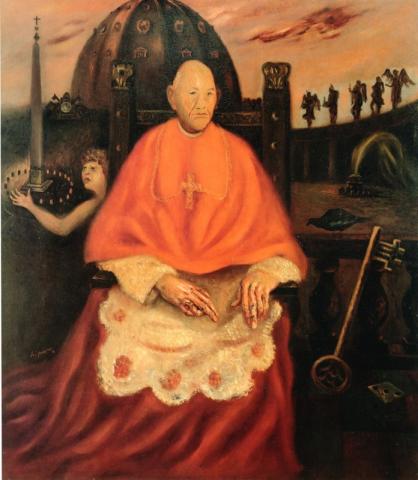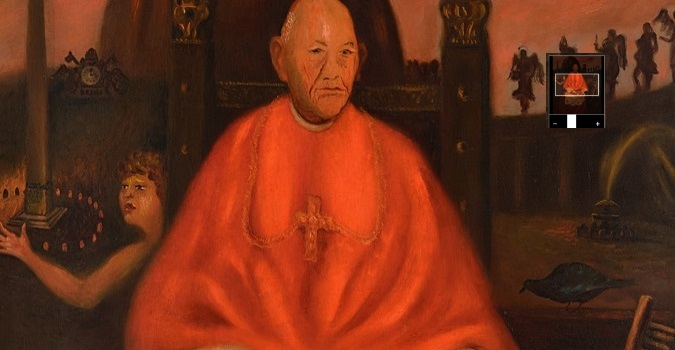The Artwork of the Month - November 2022
Scipione (Gino Bonichi)
(Macerata 1904 - Arco, TN 1933)
Il Cardinal Decano, 1930
oil painting on panel, cm 133,7 x 117,3
Inv. AM 1081

The Cardinal Decano is one of the most important paintings in the collection of the Galleria d'Arte Moderna. The work was created in 1930 by Scipione, pseudonym of Gino Bonichi, an artist who lived in the first decades of the 20th century and died prematurely.
In the centre of the composition is the 94-year-old Cardinal Vincenzo Vannutelli (1836-1930) seated on a pew. The short hair and wrinkled face reveal the advanced age of the cardinal, the 'decano' of the collegio cardinalizio. His head is turned to the right, his arms rest on the armrests with solemnity and his bony hands fall to his knees. The ring finger of the right hand is adorned with a ring. The cardinal wears on his shoulders an abundant red mozzetta, a cloak used by high clergymen, at the centre of which is a crucifix hanging from a gold collar.
To the sides of the figure and in the background the artist has placed a series of symbols, figures and architectural elements to emphasise the solemnity of ecclesiastical power. To the right, a black dove rests on a rails, supported by a large key and a three-pointed die: both elements, enlarged beyond their natural size, draw the spectator's attention to their symbolic value, alluding to Petrine power and the Passion narrative. To the left of the throne, a curly-haired angel introduces the space of the Piazza San Pietro, marked by the presence of an obelisk, a fountain and the famous colonnade with its dark dome. The colonnade is concluded at the top by a clock and five statues. Beyond the architecture, painted in dark, sombre tones, is a sky lit by red glows; the scene is therefore tinged with a subtle sense of foreboding and an ominous, apocalyptic tone.
Fascinated by the figure of Cardinal Vannutelli, Scipione portrayed him several times, including in the funeral chamber set up in July 1930 in Via Dataria. In this portrait, perhaps inspired by a photograph, the painter drew on the great models of ecclesiastical and pope portraits ( Tiziano, Velazquez, Raffaello), revisited in the light of modern painting and in particular the expressionism of Derain and Kokoschka, from which he derived the deformation of anatomy and the violent use of colour.
Scipione's artistic culture was formed in the climate of symbolism and decadentism. At a very young age, despite serious lung problems, he studied at the free school of the nude at the Academy of Rome; at the same time he increased his figurative culture by drawing and assiduously observing the old and modern masters preserved in museums, libraries and the print collection of the Calcografia Nazionale. With his meeting with Mafai and his joining the Roman School, his tastes turned more sensitively towards the European expressionist and surrealist avant-garde, which confirmed certain hallucinated and dreamlike colourings already derived - as well as from an intense and tormented religiousness - from his admiration for Goya, El Greco, Magnasco, Piranesi, Rouault and Doré.
The artist died of tuberculosis at a very young age, after two years spent in a sanatorium between Rome and Arco, in the mountains of Trentino, during which - by then unable to paint - he wrote poems, letters and diary notes, later published posthumously (Le civette gridano,1938; Carte segrete,1943).
The work, purchased in 1935 by the Governatorato di Roma as part of the II Quadriennale, is on display in the exhibition "Pasolini pittore" (29 October 2022 - 16 April 2023), in the section dedicated to "Il Novecento di Pasolini".
Return to the section > The Galleria d'Arte Moderna artwork of the month







































